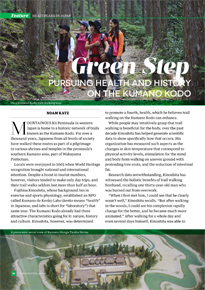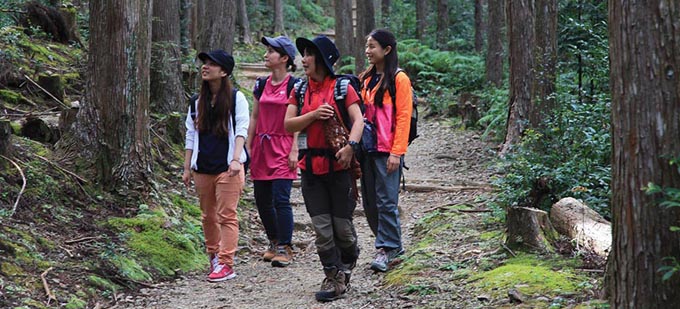Home > Highlighting JAPAN >Highlighting Japan November 2014>Healthcare in Japan
Highlighting JAPAN

Healthcare in Japan
Green Step
Pursuing Health and History on the Kumano Kodo

Mountainous Kii Peninsula in western Japan is home to a historic network of trails known as the Kumano Kodo. For over a thousand years, Japanese from all levels of society have walked these routes as part of a pilgrimage to various shrines and temples in the peninsula’s southern Kumano area, part of Wakayama Prefecture.
Locals were overjoyed in 2003 when World Heritage recognition brought national and international attention. Despite a boost in tourist numbers, however, visitors tended to make only day trips, and their trail walks seldom last more than half an hour.
Fujihisa Kinoshita, whose background lies in exercise and sports physiology, established an NPO called Kumano de Kenko Labo (kenko means “health” in Japanese, and labo is short for “laboratory”) that same year. The Kumano Kodo already had three attractive characteristics going for it: nature, history and culture. Kinoshita, however, was determined to promote a fourth, health, which he believes trail walking on the Kumano Kodo can enhance.
While people may intuitively grasp that trail walking is beneficial for the body, over the past decade Kinoshita has helped generate scientific data to show specifically how that occurs. His organization has measured such aspects as the changes in skin temperature that correspond to physical activity levels, stimulation for the mind and body from walking on uneven ground with protruding tree roots, and the reduction of intestinal fat.
Research data notwithstanding, Kinoshita has witnessed the holistic benefits of trail walking firsthand, recalling one thirty-year-old man who was burned out from overwork.
“When I first met him, I could see that he clearly wasn’t well,” Kinoshita recalls. “But after walking in the woods, I could see his complexion rapidly change for the better, and he became much more animated.” After walking for a whole day and even several days himself, Kinoshita was able to experience the health benefits of trail walking, and is convinced that it is advantageous for everyone.
Kinoshita shares a positive perspective with his walkers. For example, although he does inform them in advance of changes in elevation, he avoids voicing reminders to “be careful” when traversing up and down hills so that the walkers can focus on enjoying themselves. Roadside guardrails are referred to as “stretch boards,” since they provide a convenient way for walkers to extend much-used hamstring muscles. He believes these practices instill confidence and make for happier trekkers.
Allowing visitors to immerse themselves in the natural beauty of the forested paths and enjoy longer stays in the area would in turn support local businesses. “We’re unique in that we promote health and tourism, as well as stimulate the local economy,” adds Kinoshita. Under the concept of “health tourism,” his NPO works with local businesses to develop “stay and walk” travel packages, and organizes periodic walks for health and environmental preservation. The NPO has also trained some thirty “Kumano therapists,” who are experts in nutrition and exercise as well as regional history and culture, to lead walking tours.
One very positive outcome of these efforts is that according to the Kumano Hongu Tourist Association’s findings the number of overnight tourists has been increasing two years into the program, and the increase has remained stable. Other prefectures are taking note, and Kinoshita says he is working with officials from Okinawa to Hokkaido to develop similar programs. Kumano is serving as a model outside Japan as well, with representatives from the neighboring Republic of Korea interested in the concept as a way to reenergize their own rural areas threatened by depopulation.
The number of foreign visitors to the Kumano Kodo has increased by a factor of nearly twenty in the past ten years, according to Kinoshita. He hopes that even more people throughout Japan and the world will trek through and benefit from the Kumano Kodo’s natural and cultural landscape.
© 2009 Cabinet Office, Government of Japan






